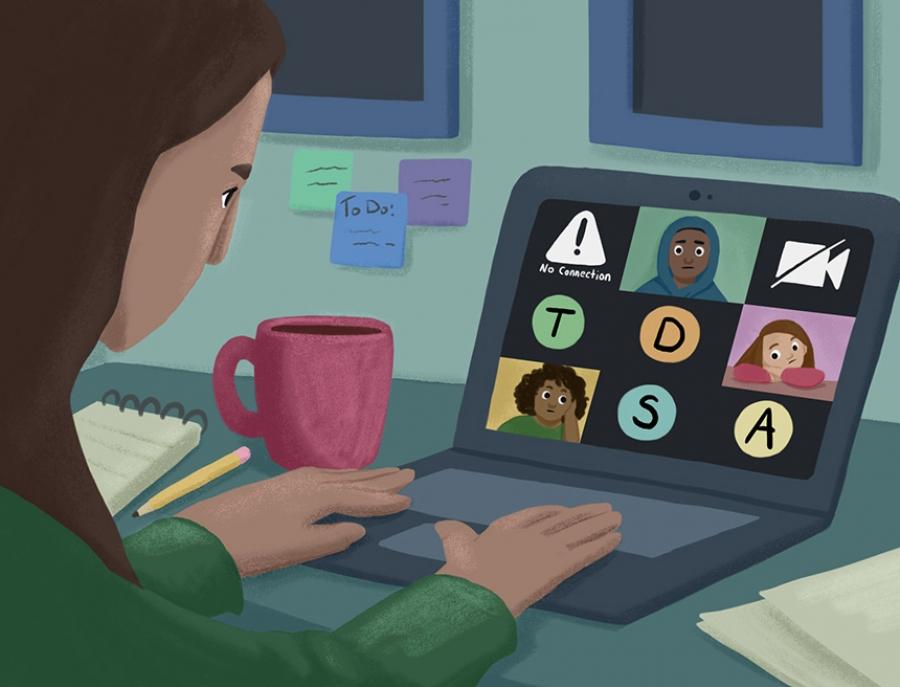Every teacher knows this dreaded experience: You ask a question and are met with a sea of blank stares and dead silence. In the age of remote learning, this experience has become even more frustrating as many of us stare at a screen filled with profile icons and muted microphones. Maybe you check the chat, hoping students have typed a response, but are met again with another blank screen.
Some teachers will argue that keeping cameras off allows students to be complacent: How do we know they aren’t asleep behind their screens, playing video games or checking apps? Truthfully, it is difficult to know. Yet, many schools — including mine — have opted not to require students to turn their cameras on. We are attempting to be trauma-informed and respect their privacy, especially in low-income districts where students may be self-conscious about their living situations. At my own school, the heated debate continues among teachers as we struggle with attendance and engagement.
Perhaps the bigger question is: How do we really measure engagement? Attendance and turning in assignments is one thing, but in regular years, these two factors do not prove a student is truly, actively engaging during class time. They may have been physically there but mentally elsewhere, rushing through work at the last minute to get assignments done, or “fake reading” their book during independent reading time. I wonder: Are students really less engaged during remote learning? Or has remote learning just revealed a lack of engagement that was always there, masked by physical attendance?
In all honesty, students have every right to be disengaged as they deal with the trauma and fatigue of the past 10 months. Many are sharing space with multiple siblings also learning remotely, doing chores and caring for family members, attempting to join class from cell phones or malfunctioning DOE-provided tablets, and using unreliable Wi-Fi, or having no W-Fi at all. If I were a 12-year-old going through that, there’s no way signing on to Google Meet, much less turning my camera on, would be a top concern.
Yet, many students continue to show up. Occasionally the cameras come on, like they did for a few precious minutes during what should have been a snow day, as students showed off their snowy window views and longed for a day of sledding.
In other words, students turn their cameras on when they feel there’s a purpose — when there is something they’re excited to show.
If having students’ cameras on is important to your teaching practice, then I highly encourage having conversations with students about what they need to feel comfortable with their camera on or designing activities that encourage showing something off: independent reading books, artwork, or math or science projects using household items. However, I also propose a shift in thinking, a reevaluation of what engagement looks and sounds like, especially in this weird world of online school.
Sometimes, engagement looks like lots of quiet thinking time. It can look like writing, drawing, talking, taking polls and answering multiple-choice questions. One of the best tools our school’s special education coordinator introduced was Pear Deck, a Google Slide add-on where activities are embedded in the slideshow and teachers can assign slides as a student-paced activity or use the instructor-paced mode during live lessons.
Pear Deck features a variety of question types to address multiple learning styles, and responses can be shown anonymously to support those shy students who wouldn’t normally respond out loud in person. In some ways, Pear Deck allows for more sharing and discussion because all students respond at the same time and all responses are projected. For teachers who wonder how to know if a student is really there without seeing their face, Pear Deck and similar platforms like NearPod can help. They allow students to actively participate throughout the lesson without having to reveal their private living space.
Of course, Pear Deck has not magically fixed everything. It has encouraged more participation from our school’s quieter students and has made class more interactive and fun, but we still face massive attendance problems that feel like they are beyond our power to control.
Quite frankly, much of what happens during remote learning is beyond our control. What is not beyond our control is our ability to think critically about what meaningful lessons look like in this landscape; what content students need at this unique moment; how to create engaging and brave spaces for students to be social, thoughtful and supported; and what philosophy shifts we can take with us to be more responsive educators when we all return to school buildings.
Carolyn Tyner is a 7th-grade ELA teacher at Sunset Park Prep in Brooklyn.
